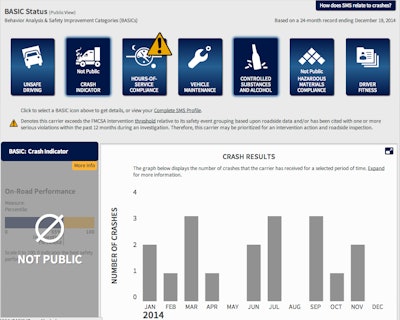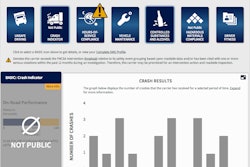 The FAST Act of 2015 pulled carriers’ CSA SMS rankings from public view and required the National Academies of Science to study the program and issue recommendations to FMCSA to fix it before the SMS can be made public again. The NAS report was made public Tuesday.
The FAST Act of 2015 pulled carriers’ CSA SMS rankings from public view and required the National Academies of Science to study the program and issue recommendations to FMCSA to fix it before the SMS can be made public again. The NAS report was made public Tuesday.A group of researchers from the National Academies of Science has issued a Congressionally mandated report recommending the U.S. DOT overhaul its Compliance, Safety, Accountability carrier rating system to make it more fair and accurate in its assessment of motor carriers’ safety risk.
Key recommendations from the NAS, who made the report public Tuesday, include:
(1) Reconfiguring the underlying statistical model under CSA’s Safety Measurement System (the percentile ranking categories used to target carriers for intervention) with a so-called item response theory (IRT) model to more accurately target at-risk carriers;
(2) making the scoring system more transparent and easier for carriers to replicate and understand; and
(3) departing from using relative metrics as the sole means for targeting carriers.
The NAS urged further study of the impact of the public display of SMS rankings and said the data used to create the rankings is in need of “immediate attention.” Researchers recommend FMCSA better collaborate with state partners and other data providers to collect more data and higher quality data, specifically related to crash reports and to carriers’ operations (miles traveled, number of power units and more).
The report, dubbed Improving Motor Carrier Safety Measurement, was called for by Congress in the 2015 FAST Act highway bill. The FAST Act also pulled the SMS’ BASIC percentile rankings from public view. The law stipulated that the NAS must issue recommendations on how the Federal Motor Carrier Safety Administration can fix the data and methodology issues that have plagued CSA since its 2011 onset — and that FMCSA adopt the recommendations — before the SMS can be made public again.
It’s unclear yet how the agency intends to act on the report’s recommendations or the timeline on which it plans to adopt any CSA reforms. FMCSA confirmed it has received the report and says it will issue a response to Congress within the 120 days allotted by the FAST Act. An agency spokesperson says it is “reviewing the findings.”
The agency has already undertaken an effort to improve crash reporting around the nation through its Post Accident Report Review Subcommittee of its Motor Carrier Safety Advisory Committee, tasked with making recommendations to improve crash-report utility and standardization.
The NAS, established by Congress in 1863 as a private institution, intends to provide nonpartisan and objective research to lawmakers and regulators to help steer policy decisions. Congress funneled the funding for the new study through FMCSA.
The NAS report on CSA and its underlying data reaches an oft-heard conclusion: While the premise behind CSA’s SMS is sound, FMCSA’s execution of the program was flawed from the ground up. CSA relies on in some ways inadequate data, NAS researchers conclude, which is then funneled into a scoring system that has not been “sufficiently empirically validated,” researchers argue. Findings in other ways reiterate conclusions reached by CCJ in recent years in its CSA’s Data Trail series, which was one among many analyses of CSA’s flaws and their impact on motor carrier businesses that prompted action on reworking the CSA program.
The report notes the chief criticisms of the CSA program: Some BASICs lack correlation with crash risk, data insufficiency, use of relative rankings, use of non-fault or nonpreventable crashes, state variations in inspections and violations, lack of consistency in violation coding, a lack of transparency of the SMS algorithm and the public availability of SMS rankings.
“Conceptually, SMS is structured reasonably,” the NAS report concludes. “However, too much of the detail of what is done is ad hoc. Instead, it would be better to make use of the appropriate statistical model, which will help address many of the issues that have been raised in a natural way and interpretable way.”
The report doesn’t go into depth about its recommendations for a new statistical model to replace the SMS model, but it touts the IRT model as one that has been proven to work in other fields, such as healthcare and education, to achieve outcomes similar to those sought by the SMS. IRT models are used in healthcare to assess the quality of care given to patients and in education to assess teachers’ performance. In both fields, IRT models are used to target poor performers for intervention, just as FMCSA does with the SMS rankings.
NAS’ principal recommendation is that FMCSA develop an IRT model over the next two years and then implement it in place of the SMS “if it [demonstrates] to perform well in identifying motor carriers for alerts.” Transitioning to an IRT model, the study’s authors believe, would in part help soothe some of these problems. It would make violation weighting more data-focused (less reliant on severity weights), provide better transparency, account for holes in data and more.
Other NAS recommendations seek to tackle SMS flaws, too. FMCSA needs to work more closely with states to homogenize data reporting and collection, researchers recommend, and find new sources to assess carriers’ safety risk, such as analyzing driver turnover rates and driver pay methods.
The agency should also build a more “user-friendly version” of the Motor Carrier Management Information System (the data well that feeds CSA) and make its scoring methodology more accessible, NAS says. Such changes would make it easier for carriers to understand how they’re being scored and learn how to improve their scores and, hence, their safety practices.
Before going public with a revamped SMS, the agency should also further analyze the ramifications of publicly displaying the SMS rankings. Shippers and brokers have to varying degrees used the rankings to deny carriers business, while insurers in some cases used the system to charge higher premiums.
Researchers also recommend FMCSA find a way to implement an absolute scoring metric into the SMS algorithm to select carriers for intervention, rather than relying solely on relative rankings. Relative ratings can be a moving target for carriers trying to boost their safety culture.
NAS will provide the roughly 130-page report to FMCSA and to Congress.











